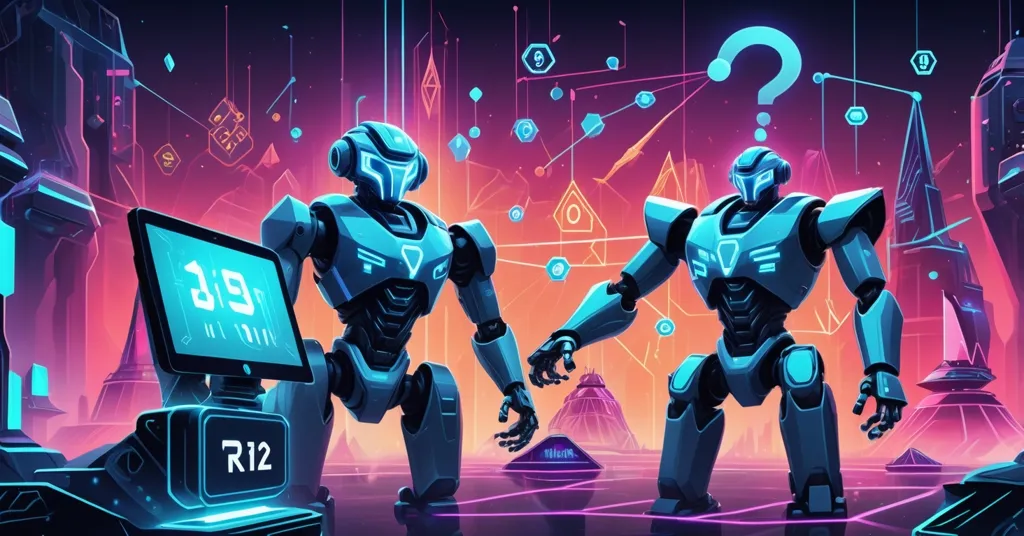Ruvi AI’s 13,233% ROI Claim: Real Innovation or Just Hype Against Tron?

Ruvi AI’s 13,233% ROI Claim: Genuine Innovation or Crypto Hype Over Tron?
A new altcoin, Ruvi AI (RUVI), has burst onto the scene with a staggering promise of a 13,233% return on investment by 2025, positioning itself as a potential rival to Tron (TRX), a blockchain veteran known for its robust infrastructure. But is this AI-blockchain hybrid the next frontier in decentralized tech, or just another speculative bubble waiting to pop?
- Ruvi AI’s Bold Prediction: Claims a 13,233% ROI by 2025 with an AI-driven content creation platform.
- Tron’s Established Presence: A 2017 blockchain with 2,000 TPS and partnerships like Samsung, now challenged by newcomers.
- Presale Discrepancies: Conflicting data on funds raised raises red flags about Ruvi AI’s credibility.
Ruvi AI’s Vision: Revolutionary or Overhyped?
Ruvi AI is marketing itself as a decentralized superapp—a multi-purpose platform not owned by a single entity, think of it as a community-run toolbox for digital creation. It aims to merge blockchain with artificial intelligence to automate content production, from text and videos to images and audio, targeting industries like marketing and business automation. The $RUVI token fuels this ecosystem, used for transactions, staking rewards, and governance, where token holders vote on project decisions much like shareholders in a company. The pitch is enticing: empowering creators to bypass centralized gatekeepers with secure, innovative tools. Reports suggest their presale has drawn significant attention, with numbers floating around $1.5 million raised from over 1,400 investors, as highlighted in some predictions of massive growth for Ruvi AI. Phase 1 tokens reportedly sold out at $0.010 in just two weeks, with Phase 2 jumping to $0.015—a 50% increase. VIP tiers add more allure, with Tier 5 offering 500,000 RUVI for a $7,500 investment and a 100% bonus, dangling that eye-popping 13,233% ROI if the token hits $1 post-launch.
But let’s hit pause and dig into the numbers. Conflicting data paints a murkier picture. Some sources report a mere $100,000 raised from selling 10 million tokens at $0.01, with VIP Tier 5 costing $5,000 and projecting a 200x return at a $1 target—nowhere near the 13,233% figure. This isn’t a minor glitch; it’s a glaring inconsistency that screams for scrutiny. Is this outdated info, sloppy reporting, or a deliberate inflation to hook naive investors? In the crypto space, where scams and rug pulls hide behind every flashy presale, such discrepancies are a massive warning sign. While mentions of a beta product launch offer a sliver of tangibility, the lack of transparent details on funds raised or investor numbers leaves us questioning the foundation of Ruvi AI’s hype. A deeper look into its project legitimacy and tech background might shed some light on these concerns.
Tron’s Track Record: Stability Under Siege?
Now, let’s shift gears to Tron (TRX), a blockchain that’s been battle-tested since 2017. Its core mission is decentralized content sharing, allowing creators to monetize directly without middlemen. Boasting a capacity of 2,000 transactions per second (TPS), Tron is a scalability powerhouse, making it a go-to for developers building decentralized apps (dApps). Its ecosystem is bolstered by high-profile partnerships with Samsung and the acquisition of BitTorrent, a peer-to-peer file-sharing giant, cementing its credibility. Tron consistently ranks among top blockchains by market cap, with a thriving DeFi presence through platforms like JustLend and SunSwap. According to DappRadar, Tron’s total value locked (TVL) in DeFi often exceeds billions, showcasing real user adoption. For a detailed look at how it stacks up against newcomers, check this comparison of Tron and Ruvi AI on scalability and partnerships.
Yet, Tron isn’t without flaws. Critics often point to centralization concerns, with founder Justin Sun’s influence raising eyebrows about true decentralization—a core value we champion. Additionally, Tron’s innovation has plateaued compared to newer protocols integrating cutting-edge tech like AI or layer-2 scaling solutions. While it remains a reliable player, it’s less of a darling for speculators chasing the next 100x coin. So, can a newcomer like Ruvi AI, with its trendy AI-blockchain combo, pose a genuine threat, or is Tron’s entrenched infrastructure too formidable?
The 13,233% ROI: Fairy Tale or Fraud?
Let’s tackle the elephant in the room: Ruvi AI’s claim of a 13,233% return on investment by 2025. For clarity, ROI measures profit relative to your initial stake. If you invest $1 at $0.01 per token, you get 100 tokens. If the price climbs to $1 per token, your holdings are worth $100—a 9,900% gain. The 13,233% figure implies even loftier returns, but with zero transparency on how it’s calculated. Who are these unnamed “analysts” behind the prediction? Where’s the methodology or market analysis to support it? Without hard data, this smells like the kind of shilling that fueled the 2017-2018 ICO bubble, where over 80% of projects either flopped or outright scammed investors—think BitConnect, which promised similar moonshot gains before collapsing in a Ponzi scheme disaster. Questions about the credibility of these projections are discussed in this analysis of Ruvi AI’s ROI claims.
Crypto’s history is littered with such cautionary tales, and Ruvi AI’s lack of substantiation places it squarely in speculative territory. Even their reported milestones—an exchange listing and a partnership with a major trading platform—feel like breadcrumbs rather than proof of a revolution. Compare this to Tron, where tangible metrics like TPS, TVL, and active dApps offer a measurable track record. Ruvi AI’s presale might tempt those driven by fear of missing out on the next big thing, but the risk of getting burned is as high as a house of cards in a windstorm. Community skepticism is evident in discussions on platforms like Reddit about Ruvi AI’s ROI promises.
Could Ruvi AI Still Disrupt the Game?
Now, playing devil’s advocate, let’s not write off Ruvi AI entirely. The concept of blending AI with blockchain isn’t mere buzzword salad; it’s a burgeoning field with potential. Projects like Fetch.AI and SingularityNET have demonstrated viable use cases, from fraud detection to supply chain optimization. If Ruvi AI can deliver on its vision, small creators could ditch expensive centralized platforms like Adobe or Shutterstock, crafting content securely on a decentralized network—a true win for the ethos of freedom and disruption we root for. Their governance model, allowing community input, also aligns with decentralization principles. But here’s the rub: execution is everything. How does their AI ensure quality or avoid plagiarism? How secure is their blockchain against hacks? Without a proven product beyond a vague beta, it’s a gamble dressed as innovation. For broader context on similar initiatives, explore this analysis of AI-driven blockchain projects.
Regulatory Storm Clouds and Altcoin Risks
Beyond tech challenges, there’s a bigger shadow looming: regulation. Crypto is under intense scrutiny worldwide, with bodies like the U.S. Securities and Exchange Commission (SEC) cracking down on unregistered securities. Presale structures like Ruvi AI’s, especially with VIP tiers promising outsized returns, could easily catch regulatory heat—look at the ongoing Ripple (XRP) case, where the SEC alleges XRP sales violated securities laws. If Ruvi AI’s token is deemed a security, the project could face legal battles that stall or sink it before it even launches. Investors jumping into unproven altcoins must weigh not just market volatility but the very real chance of waking up to a cease-and-desist order wiping out their stake. Some investors are asking critical questions about its viability on platforms like Quora regarding Ruvi AI’s legitimacy.
Bitcoin’s Lens: The True North of Decentralization
As Bitcoin maximalists at heart, we can’t help but view this showdown through the lens of BTC’s unmatched role as sound money. Bitcoin is the bedrock of financial freedom, a defiant stand against fiat inflation and centralized control, needing no flashy gimmicks to prove its worth. Altcoins like Tron and Ruvi AI explore niches—dApps for content sharing or AI-driven creation tools—that Bitcoin shouldn’t and doesn’t need to touch. Tron’s ecosystem drives adoption in practical ways, with real users and locked value, while Ruvi AI, if it delivers, could onboard creators to decentralized tech en masse. Yet, the speculative fever around such projects often distracts from Bitcoin’s core mission. For every Ethereum that carves a lasting space, countless altcoins vanish into obscurity, and Ruvi AI’s hype-to-substance ratio leans dangerously toward the latter. Curious readers can find more background on the project through this WikiBit entry on Ruvi AI.
The Bigger Picture: Hype vs. Substance
So, where do we land? Ruvi AI might be a wildcard with a compelling idea, but its inflated ROI claims and murky presale data scream caution louder than a bull market rally. Tron offers a safer harbor with its proven tech and user base, though it’s not immune to being outpaced by bolder innovators. If you’re tempted by Ruvi AI’s presale, approach it like a soldier crossing a minefield—those VIP tier promises are tantalizing, but the odds of a wipeout are sky-high. To the teams and so-called analysts peddling these absurd projections: spare us the nonsense. Focus on transparent data and real progress to build trust in this space. Crypto’s revolution thrives on builders, not hype merchants. Before diving into any new token, dig into whitepapers, team credibility, and community feedback—skepticism is as vital as innovation in pushing decentralization forward. Will Ruvi AI defy the odds to reshape content creation, or is Tron’s steady grind a better bet for the future of decentralized tech?
Key Questions and Takeaways on Ruvi AI and Tron
- What is Ruvi AI, and why is it turning heads?
Ruvi AI is a blockchain-AI platform focused on automated content creation as a decentralized superapp, gaining buzz for its presale and a claimed 13,233% ROI by 2025. - How does Tron hold its ground against upstarts like Ruvi AI?
Tron leverages its 2017 launch, 2,000 TPS scalability, and partnerships like Samsung, offering reliability and a robust dApp ecosystem that new projects struggle to rival. - Is Ruvi AI’s 13,233% ROI claim credible?
Highly unlikely—it’s unsupported by clear data or methodology, with conflicting presale figures adding to doubts, reminiscent of past crypto scam hype. - Should investors consider Ruvi AI’s presale for big gains?
Only with extreme caution; the concept has potential, but unproven tech, regulatory risks, and questionable numbers make it a high-stakes gamble. - What role do altcoins like Ruvi AI and Tron play next to Bitcoin?
They target niche applications like content tools and dApps, boosting decentralized tech adoption, though they often lack Bitcoin’s fundamental strength as sound money.



